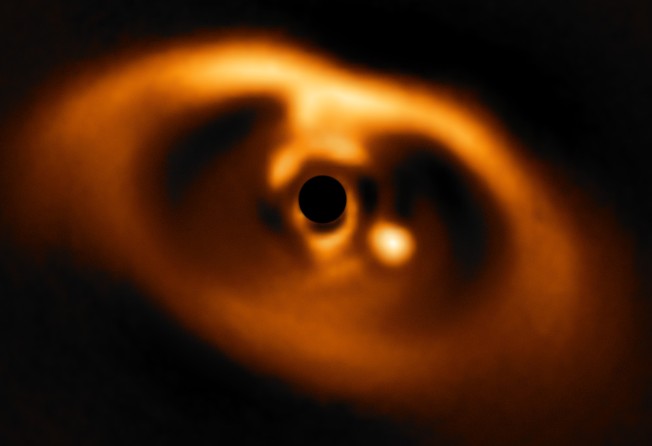Ultimate baby photo: remarkable image is first to show a planet being born
The bright blob depicts a newborn planet emerging from a star about 370 light years from Earth

It is a moment of birth that has previously proved elusive, but astronomers say they now have the first confirmed image of the formation of a planet.
The startling snapshot shows a bright blob – the nascent planet – travelling through the dust and gas surrounding a young star, known as PDS70, thought to be about 370 light years from Earth.
The black circle in the centre of the image, to the left of the planet, is a filter to block the light from the star, enabling other features of the system to be seen.
Captured by the Sphere instrument of the European Southern Observatory’s Very Large Telescope, the planet – a gas giant with a mass greater than Jupiter – is about as far from its star as Uranus is from our Sun, with further analyses revealing that it appears to have a cloudy atmosphere and a surface temperature of 1,000 degrees Celsius.
“These discs around young stars are the birthplaces of planets, but so far only a handful of observations have detected hints of baby planets in them,” said Miriam Keppler of the Max Planck Institute for Astronomy in Germany, a lead author of the research published in the journal Astronomy and Astrophysics. However, other ground-based observations have not yielded conclusive evidence.
“The problem is that until now, most of these planet candidates could just have been features in the disc,” she said. “The advantage of our detection is that we have detected [the new planet] with several different observing instruments, different filter bands and different years,” she added.
Young planets have also previously been identified using the orbiting Kepler telescope. But that method, said Keppler, also has limitations, relying on a dimming of the star’s light as a body moves in between it and the telescope.
“The special thing about this new planet is that we can directly image it, so the ones by Kepler, for example, they were derived by indirect techniques,” she said “In this case we now have a direct image [of the planet] in its ‘birthplace’, which is the circumstellar disc. This is especially important because people have been wondering [for a long time], how these planets actually form and how the dust and the material in this disc forms [into] a planet, and now we can directly observe this.”